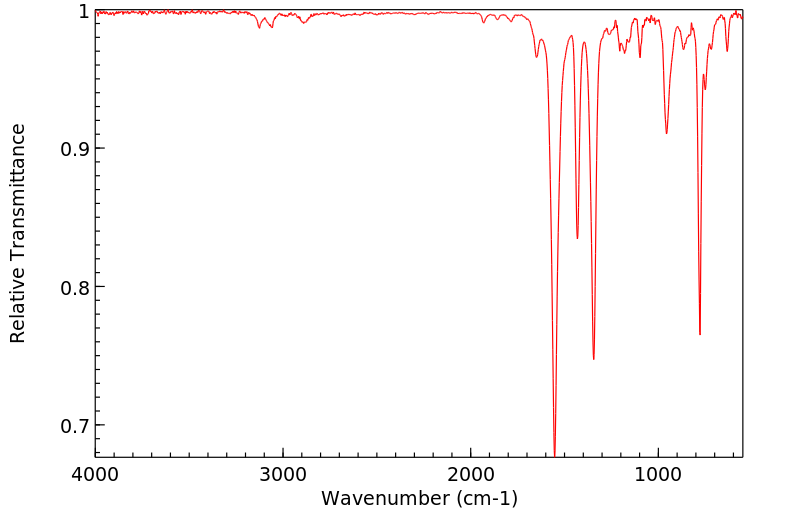反-2,6-二氯-β-硝基苯乙烯 | 52287-52-2
中文名称
反-2,6-二氯-β-硝基苯乙烯
中文别名
——
英文名称
(E)-1,3-dichloro-2-(2-nitrovinyl)benzene
英文别名
1,3-dichloro-2-(2-nitrovinyl)benzene;(E)-2,6-dichloro-1-(2-nitrovinyl)benzene;trans-2,6-dichloro-β-nitrostyrene;1,3-Dichloro-2-[(E)-2-nitroethenyl]benzene
CAS
52287-52-2
化学式
C8H5Cl2NO2
mdl
——
分子量
218.039
InChiKey
VXNHQIKJDIOBEC-SNAWJCMRSA-N
BEILSTEIN
——
EINECS
——
-
物化性质
-
计算性质
-
ADMET
-
安全信息
-
SDS
-
制备方法与用途
-
上下游信息
-
文献信息
-
表征谱图
-
同类化合物
-
相关功能分类
-
相关结构分类
物化性质
-
熔点:63-67 °C (lit.)
计算性质
-
辛醇/水分配系数(LogP):3.4
-
重原子数:13
-
可旋转键数:1
-
环数:1.0
-
sp3杂化的碳原子比例:0.0
-
拓扑面积:45.8
-
氢给体数:0
-
氢受体数:2
安全信息
-
WGK Germany:3
SDS
上下游信息
-
上游原料
中文名称 英文名称 CAS号 化学式 分子量 2,6-二氯苯乙烯 2,6-dichlorostyrene 28469-92-3 C8H6Cl2 173.042
反应信息
-
作为反应物:描述:反-2,6-二氯-β-硝基苯乙烯 在 lithium aluminium tetrahydride 作用下, 以 乙醚 为溶剂, 反应 3.0h, 以58%的产率得到2,4-二氯苯酚呋喃参考文献:名称:Gasteiger; Holzgrabe; Kostenis, Pharmazie, 1995, vol. 50, # 2, p. 99 - 105摘要:DOI:
-
作为产物:描述:参考文献:名称:THERAPEUTIC COMPOUNDS摘要:该发明提供了式Ia′、Ib′、Ic′和Id′的化合物及其药学上可接受的盐,其中变量A、R6、R7、R8、R9、Rx、L、X、Y和Z的含义如本文所述。这些化合物对于减少内质网应激并在动物体内产生镇痛作用是有用的。公开号:US20180230105A1
文献信息
-
Organocatalytic Biomimetic Reduction of Conjugated Nitroalkenes作者:Peter Schreiner、Zhiguo ZhangDOI:10.1055/s-2007-983805日期:2007.8A thiourea-catalyzed biomimetic reduction of conjugated nitroalkenes has been developed. Various aromatic and aliphatic conjugated nitroalkenes can be reduced to give the respective nitroalkanes with good yields under mild conditions. This protocol is not only practical, but may also provide insight into the mechanisms of redox transformations in biological systems.
-
Organocatalytic, Enantioselective Conjugate Addition of Nitroalkanes to Nitroolefins作者:Jian Wang、Hao Li、Liansuo Zu、Wei Jiang、Wei WangDOI:10.1002/adsc.200600247日期:2006.10An organocatalytic, enantioselective conjugate addition reaction of nitroalkanes with nitroolefins has been developed under neat conditions without using an organic solvent. The process, catalyzed by a modified Cinchona alkaloid, affords synthetically useful 1,3-dinitro compounds in good yields (70–82 %) with good degrees of enantioselectivity (67–88 % ee).
-
Straightforward Synthesis of 1,2-Dicyanoalkanes from Nitroalkenes and Silyl Cyanide Mediated by Tetrabutylammonium Fluoride作者:Kensuke Kiyokawa、Takaya Nagata、Junpei Hayakawa、Satoshi MinakataDOI:10.1002/chem.201404780日期:2015.1.12A straightforward synthesis of 1,2‐dicyanoalkanes by reacting nitroalkenes with trimethylsilyl cyanide in the presence of tetrabutylammonium fluoride is described. The reaction proceeds through a tandem double Michael addition under mild conditions. Employing the hypervalent silicate generated from trimethylsilyl cyanide and tetrabutylammonium fluoride is essential for achieving this transformation
-
1,3-Diamine-Derived Bifunctional Organocatalyst Prepared from Camphor作者:Sebastijan Ričko、Jurij Svete、Bogdan Štefane、Andrej Perdih、Amalija Golobič、Anže Meden、Uroš GrošeljDOI:10.1002/adsc.201600498日期:2016.12.7motifs in organocatalysis, whereas efficient 1,3‐diamine‐derived organocatalysts are very rare. Herein we report a highly efficient camphor‐1,3‐diamine‐derived squaramide organocatalyst. Its catalytic activity in Michael additions of 1,3‐dicarbonyl nucleophiles to trans‐β‐nitrostyrene derivatives provides excellent enantioselectivities (up to >99% ee).
-
Modular synthesis of cyclic cis- and trans-1,2-diamine derivatives作者:Anna K. Weber、Josef Schachtner、Robert Fichtler、Timo M. Leermann、Jörg M. Neudörfl、Axel Jacobi von WangelinDOI:10.1039/c4ob00913d日期:——substituted nitroarenes. Reduction with Zn/HCl provides access to various trans- and cis-diaminocyclohexenes, respectively, in a straight-forward manner. With enantiopure secondary amines, a two-step synthesis of chiral nitrocyclohexadienes was developed (82–94% ee).
表征谱图
-
氢谱1HNMR
-
质谱MS
-
碳谱13CNMR
-
红外IR
-
拉曼Raman
-
峰位数据
-
峰位匹配
-
表征信息
同类化合物
(βS)-β-氨基-4-(4-羟基苯氧基)-3,5-二碘苯甲丙醇
(S,S)-邻甲苯基-DIPAMP
(S)-(-)-7'-〔4(S)-(苄基)恶唑-2-基]-7-二(3,5-二-叔丁基苯基)膦基-2,2',3,3'-四氢-1,1-螺二氢茚
(S)-盐酸沙丁胺醇
(S)-3-(叔丁基)-4-(2,6-二甲氧基苯基)-2,3-二氢苯并[d][1,3]氧磷杂环戊二烯
(S)-2,2'-双[双(3,5-三氟甲基苯基)膦基]-4,4',6,6'-四甲氧基联苯
(S)-1-[3,5-双(三氟甲基)苯基]-3-[1-(二甲基氨基)-3-甲基丁烷-2-基]硫脲
(R)富马酸托特罗定
(R)-(-)-盐酸尼古地平
(R)-(-)-4,12-双(二苯基膦基)[2.2]对环芳烷(1,5环辛二烯)铑(I)四氟硼酸盐
(R)-(+)-7-双(3,5-二叔丁基苯基)膦基7''-[((6-甲基吡啶-2-基甲基)氨基]-2,2'',3,3''-四氢-1,1''-螺双茚满
(R)-(+)-7-双(3,5-二叔丁基苯基)膦基7''-[(4-叔丁基吡啶-2-基甲基)氨基]-2,2'',3,3''-四氢-1,1''-螺双茚满
(R)-(+)-7-双(3,5-二叔丁基苯基)膦基7''-[(3-甲基吡啶-2-基甲基)氨基]-2,2'',3,3''-四氢-1,1''-螺双茚满
(R)-(+)-4,7-双(3,5-二-叔丁基苯基)膦基-7“-[(吡啶-2-基甲基)氨基]-2,2”,3,3'-四氢1,1'-螺二茚满
(R)-3-(叔丁基)-4-(2,6-二苯氧基苯基)-2,3-二氢苯并[d][1,3]氧杂磷杂环戊烯
(R)-2-[((二苯基膦基)甲基]吡咯烷
(R)-1-[3,5-双(三氟甲基)苯基]-3-[1-(二甲基氨基)-3-甲基丁烷-2-基]硫脲
(N-(4-甲氧基苯基)-N-甲基-3-(1-哌啶基)丙-2-烯酰胺)
(5-溴-2-羟基苯基)-4-氯苯甲酮
(5-溴-2-氯苯基)(4-羟基苯基)甲酮
(5-氧代-3-苯基-2,5-二氢-1,2,3,4-oxatriazol-3-鎓)
(4S,5R)-4-甲基-5-苯基-1,2,3-氧代噻唑烷-2,2-二氧化物-3-羧酸叔丁酯
(4S,4''S)-2,2''-亚环戊基双[4,5-二氢-4-(苯甲基)恶唑]
(4-溴苯基)-[2-氟-4-[6-[甲基(丙-2-烯基)氨基]己氧基]苯基]甲酮
(4-丁氧基苯甲基)三苯基溴化磷
(3aR,8aR)-(-)-4,4,8,8-四(3,5-二甲基苯基)四氢-2,2-二甲基-6-苯基-1,3-二氧戊环[4,5-e]二恶唑磷
(3aR,6aS)-5-氧代六氢环戊基[c]吡咯-2(1H)-羧酸酯
(2Z)-3-[[(4-氯苯基)氨基]-2-氰基丙烯酸乙酯
(2S,3S,5S)-5-(叔丁氧基甲酰氨基)-2-(N-5-噻唑基-甲氧羰基)氨基-1,6-二苯基-3-羟基己烷
(2S,2''S,3S,3''S)-3,3''-二叔丁基-4,4''-双(2,6-二甲氧基苯基)-2,2'',3,3''-四氢-2,2''-联苯并[d][1,3]氧杂磷杂戊环
(2S)-(-)-2-{[[[[3,5-双(氟代甲基)苯基]氨基]硫代甲基]氨基}-N-(二苯基甲基)-N,3,3-三甲基丁酰胺
(2S)-2-[[[[[((1S,2S)-2-氨基环己基]氨基]硫代甲基]氨基]-N-(二苯甲基)-N,3,3-三甲基丁酰胺
(2S)-2-[[[[[[((1R,2R)-2-氨基环己基]氨基]硫代甲基]氨基]-N-(二苯甲基)-N,3,3-三甲基丁酰胺
(2-硝基苯基)磷酸三酰胺
(2,6-二氯苯基)乙酰氯
(2,3-二甲氧基-5-甲基苯基)硼酸
(1S,2S,3S,5S)-5-叠氮基-3-(苯基甲氧基)-2-[(苯基甲氧基)甲基]环戊醇
(1S,2S,3R,5R)-2-(苄氧基)甲基-6-氧杂双环[3.1.0]己-3-醇
(1-(4-氟苯基)环丙基)甲胺盐酸盐
(1-(3-溴苯基)环丁基)甲胺盐酸盐
(1-(2-氯苯基)环丁基)甲胺盐酸盐
(1-(2-氟苯基)环丙基)甲胺盐酸盐
(1-(2,6-二氟苯基)环丙基)甲胺盐酸盐
(-)-去甲基西布曲明
龙蒿油
龙胆酸钠
龙胆酸叔丁酯
龙胆酸
龙胆紫-d6
龙胆紫







